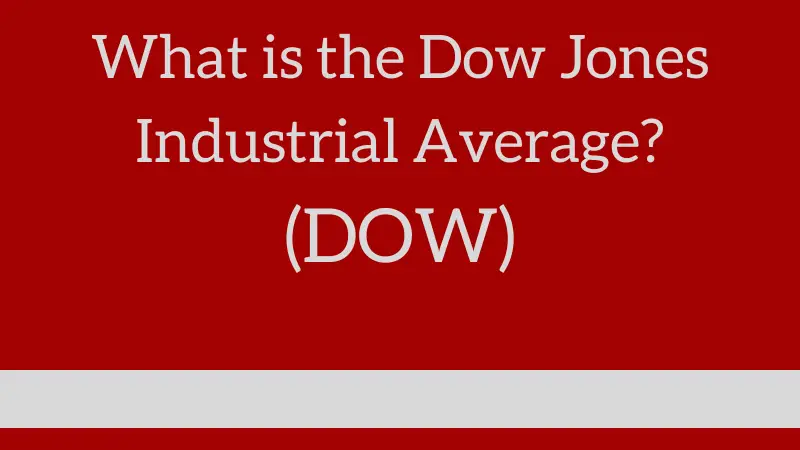What is the Dow Jones Industrial Average?

What is the Dow Jones Industrial Average? The Dow Jones Industrial Average (DJIA), also known as the Dow Jones or simply the Dow, is a stock market index that tracks the performance of 30 large, publicly traded companies listed on the New York Stock Exchange (NYSE) and the Nasdaq. The DJIA was created in 1896 by Charles Dow, the founder of Dow Jones & Company, and Edward Jones, a statistician. It is different from the S&P 500 which tracks the performance of 500 companies.
How Does the Dow Work?
The Dow Jones Industrial Average (DJIA) is calculated using a price-weighted formula, which means that the stocks in the index are weighted based on their stock prices, rather than their market capitalization or other factors. Here’s how the calculation works:
- Determine the total value of the 30 stocks in the index: The DJIA is calculated by adding up the stock prices of the 30 component companies in the index. This gives us the total value of all the stocks in the index.
- Calculate the divisor: A divisor is a number that is used to adjust the DJIA for stock splits, mergers, and other corporate actions that could affect the index. The divisor is adjusted periodically to maintain continuity in the index’s historical data.
- Divide the total value of the stocks by the divisor: The final step is to divide the total value of the stocks by the divisor. This gives us the DJIA value.
For example, if the total value of the 30 stocks in the DJIA is $1,000 and the divisor is 0.1234, then the DJIA value would be $8,099.51 (1,000 / 0.1234 = 8,099.51).
Because the DJIA is price-weighted, stocks with higher prices have a greater impact on the index’s value. This means that changes in the stock price of a high-priced stock like Apple can have a bigger effect on the index than changes in the stock price of a lower-priced stock like General Electric.
What Is the List of Companies on the Dow?
As of my knowledge cutoff of February 2023, the 30 component companies of the Dow Jones Industrial Average (DJIA) were:
3M
American Express
Amgen
Apple
Boeing
Caterpillar
Chevron
Cisco Systems
Coca-Cola
Disney
Dow Inc.
Goldman Sachs
Home Depot
Honeywell
IBM
Intel
Johnson & Johnson
JPMorgan Chase
McDonald’s
Merck
Microsoft
Nike
Procter & Gamble
Salesforce
The Travelers Companies
UnitedHealth Group
Verizon Communications
Visa
Walgreens Boots Alliance
Walmart
The companies included in the DJIA can change over time as the index’s managers seek to maintain their representation of the US stock market. Companies may be added or removed from the index based on a number of factors, including their size, financial stability, and reputation.
History of the Dow Jones Industrial Average
The DJIA has a long and rich history dating back to its creation in 1896. Here are some key events and milestones in the history of the DJIA:
- May 26, 1896: The DJIA is created by Charles Dow and Edward Jones with 12 component companies.
- 1928: The DJIA reaches 200 points for the first time.
- 1929: The stock market crash of 1929 and the subsequent Great Depression caused the DJIA to lose nearly 90% of its value, hitting a low of 41.22 in July 1932.
- 1954: The DJIA surpasses its pre-Depression peak and closes above 300 for the first time.
- 1972: The DJIA closes above 1,000 for the first time.
- 1982-1987: The DJIA experiences a prolonged bull market, with the index more than tripling in value from 1982 to 1987.
- October 19, 1987: Black Monday, one of the largest one-day percentage drops in stock market history, sees the DJIA lose 22.6% of its value in a single day.
- 1999-2000: The dot-com bubble sees the DJIA soar to a record high of 11,722.98 on January 14, 2000, before crashing amid the collapse of numerous internet-related companies.
- 2008-2009: The global financial crisis sees the DJIA lose more than half of its value, hitting a low of 6,547.05 on March 9, 2009.
- March 18, 2021: The DJIA hits a record high of 32,423.15.
- January 5, 2022: The DJIA hits a record high of 36,952.65
How to Invest in the Dow Jones Industrial Average?
Investing in the Dow Jones Industrial Average (DJIA) is a popular way for investors to gain exposure to the overall stock market in the United States. However, like any other type of investing, it involves risk. So it is important to do your research and consult with a financial advisor before making any investment decisions. Here are the steps to invest in the DJIA:
Choose a brokerage firm: To invest in the DJIA, you need to open a brokerage account with a reputable brokerage firm. Some popular options include Charles Schwab, Fidelity, TD Ameritrade, E-Trade, and Robinhood.
Fund your account: Once you have chosen a brokerage firm, you need to fund your account with money to invest in the DJIA. You can do this by transferring money from your bank account to your brokerage account.
Decide on an investment strategy: There are several ways to invest in the DJIA, including buying individual stocks that are part of the index, buying exchange-traded funds (ETFs) that track the DJIA, or investing in mutual funds that include DJIA stocks.
Place your trade: Once you have decided on an investment strategy, you can place your trade through your brokerage account. If you are buying individual stocks, you will need to search for the stocks that are part of the DJIA and place a buy order for the number of shares you want to purchase. If you are buying ETFs or mutual funds, you can search for those investments and place a buy order for the amount you want to invest.
Monitor your investments: After you have invested in the DJIA, it is important to monitor your investments regularly to make sure they are performing as expected. You should also consider adjusting your investment strategy over time based on changes in the market and your personal financial goals.
The Importance of the Dow
Overall, with a market cap of $9.7 trillion, the Dow Jones Industrial Average is an important tool for Investors and Financial Professionals who are interested in understanding the performance of the US economy and the stock market. It provides a widely recognized and trusted benchmark for tracking trends and making investment decisions.


